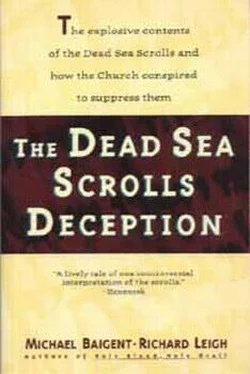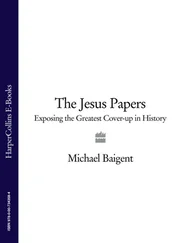In any case, and despite his exculpatory self-purification, Paul continues to inspire enmity in those ‘zealous for the Law’ — who, a few days later, attack him in the Temple. ‘This’, they proclaim, ‘is the man who preaches to everyone everywhere… against the Law’ (Acts 21:28). The ensuing riot is no minor disturbance:
This roused the whole city: people came running from all sides; they seized Paul and dragged him out of the Temple, and the gates were closed behind them. They would have killed him if a report had not reached the tribune of the cohort that there was rioting all over Jerusalem. (Acts 21:30-31)
The cohort is called out — no fewer than six hundred men — and Paul, in the nick of time, is rescued, presumably to prevent civil upheaval on an even greater scale. Why else would the cohort bother to save the life of one heterodox Jew who’d incurred the wrath of his fellows? The sheer scale of the tumult attests to the kind of currency, influence and power the so-called ‘early Church’ must have exercised in Jerusalem at the time — among Jewsl Clearly, we are dealing with a movement within Judaism itself, which commands loyalty from much of the city’s populace.
Having rescued him from the incensed mob, the Romans arrest Paul — who, before he is marched off to prison, asks permission to make a self-exonerating speech. Inexplicably, the Romans acquiesce to his request, even though the speech serves only to further inflame the mob. Paul is then carried off for torture and interrogation. As was asked previously, interrogation about what? Why torture and interrogate a man who has offended his co-religionists on fine points of orthodoxy and ritual observance? There is only one explanation for the Romans taking such an interest — that Paul is suspected of being privy to information of a political and/or military nature.
The only serious political and/or military adversaries confronting the Romans were the adherents of the nationalistic movement — the ‘Zealots’ of popular tradition. And Paul, the evangelist of the ‘early Church’, was under threat from those ‘zealous for the Law’ – forty or more of them in number — who were plotting to kill him, vowing not to eat or drink until they had done so. Saved from this fate by his hitherto unmentioned nephew, he is bundled, under escort, out of Jerusalem to Caesarea, where he invokes his right as a Roman citizen to make a personal appeal to the emperor. While in Caesarea, he hobnobs in congenial and intimate fashion with the Roman procurator, Antonius Felix. Eisenman has emphasised that he is also intimate with the procurator’s brother-in-law, Herod Agrippa II, and with the king’s sister — later the mistress of Titus, the Roman commander who will destroy Jerusalem and eventually become emperor. 3
These are not the only suspicious elements looming in the background of Paul’s biography. From the very beginning, his apparent wealth, his Roman citizenship and his easy familiarity with the presiding establishment have differentiated him from his fellows and from other members of the ‘early Church’. Obviously, he has influential connections with the ruling elite. How else could so young a man have become the high priest’s hatchet man? In his letter to the Romans (16:11), moreover, he speaks of a companion strikingly named ‘Herodion’ — a name obviously associated with the reigning dynasty, and most unlikely for a fellow evangelist. And Acts 13:1 refers to one of Paul’s companions in Antioch as ‘Manaen, who had been brought up with Herod the Tetrarch’. Here, again, there is evidence of high-level aristocratic affiliation. 4
Startling though the suggestion may be, it does seem at least possible that Paul was some species of Roman ‘agent’. Eisenman was led to this conclusion by the scrolls themselves, then found the references in the New Testament to support it. And indeed, if one combines and superimposes the materials found at Qumran with those in Acts, together with obscure references in Paul’s letters, such a conclusion becomes a distinct possibility. But there is another possibility as well, possibly no less startling. Those last muddled and enigmatic events in Jerusalem, the nick-of-time intervention of the Romans, Paul’s heavily escorted departure from the city, his sojourn in luxury at Caesarea, his mysterious and utter disappearance from the stage of history — these things find a curious echo in our own era. One is reminded of beneficiaries of the ‘Witness Protection Program’ in the States. One is also reminded of the so-called ‘supergrass phenomenon’ in Northern Ireland. In both cases, a member of an illicit organisation — dedicated to organised crime or to paramilitary terrorism — is ‘turned’ by the authorities. He consents to give evidence and testify, in exchange for immunity, protection, relocation and money. Like Paul, he would incur the vengeful wrath of his colleagues. Like Paul, he would be placed under seemingly disproportionate military and/or police protection. Like Paul, he would be smuggled out under escort. Having co-operated with the authorities, he would then be given a ‘new identity’ and, together with his family, resettled somewhere theoretically out of reach of his vindictive comrades. So far as the world at large was concerned, he would, like Paul, disappear.
Does Paul, then, belong in the company of history’s ‘secret agents’? Of history’s informers and ‘supergrasses’? These are some of the questions generated by Robert Eisenman’s research. But in any case, Paul’s arrival on the scene set a train of events in motion that was to prove irreversible. What began as a localised movement within the framework of existing Judaism, its influence extending no further than the Holy Land, was transformed into something of a scale and magnitude that no one at the time can have foreseen. The movement entrusted to the ‘early Church’ and the Qumran community was effectively hijacked and converted into something that could no longer accommodate its progenitors. There emerged a skein of thought which, heretical at its inception, was to evolve in the course of the next two centuries into an entirely new religion. What had been heresy within the framework of Judaism was now to become the orthodoxy of Christianity. Few accidents of history can have had more far-reaching consequences.
The story of the scrolls is, needless to say, unfinished. The plot continues to unfold, taking new twists and turns. Much has happened since this book appeared in Great Britain in May 1991. By the autumn, things had built to a climax, and the scrolls were the subject of front page coverage, as well as editorials, in such newspapers as The New York Times. Even as the American edition of our book is being prepared for publication, other books and articles are appearing in print, conferences are being convened, media attention is intensifying, various protagonists are issuing new statements.
In May, the Israeli ‘Oversight Committee’ granted to Oxford University a complete set of photographs of all scroll material, and a centre for scroll research was established under the auspices of Gaza Vermes. Access, however, was still rigorously restricted, still denied to independent scholars. Interviewed on British television, Professor Norman Golb of the University of Chicago queried the purpose of such a centre. Was it, he asked, simply to be a centre of frustration?
On 5 September, the American press reported that two scholars at Hebrew Union College in Cincinnati, Professor Ben-Zion Wacholder and one of his doctoral students, Martin G. Abegg, had ‘broken the monopoly’ of the Dead Sea Scrolls. Using the concordance prepared by the international team in the 1950s, they had then employed a computer to reconstruct the texts themselves. The results, said to be 80 percent accurate, were published by the Biblical Archaeology Society under Hershel Shanks. The surviving members of the international team were predictably furious. Professor Cross inveighed against ‘piracy’. ‘What else would you call it,’ the deposed John Strugnall fulminated, ‘but stealing?’ On 7 September, however, an editorial in The New York Times endorsed Wacholder’s and Abegg’s action:
Читать дальше












